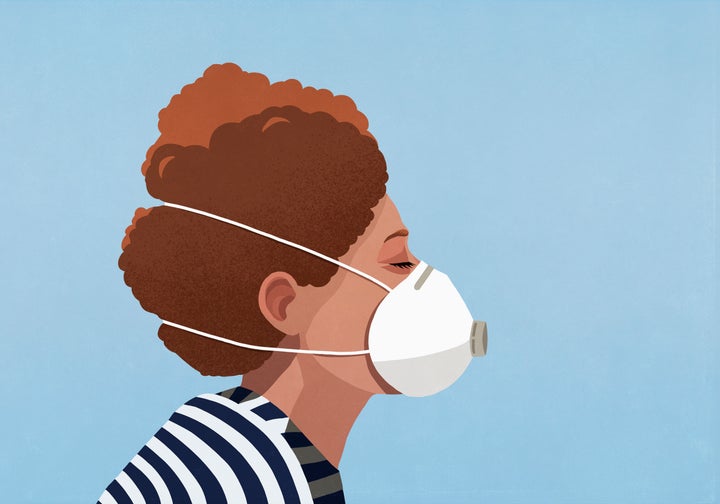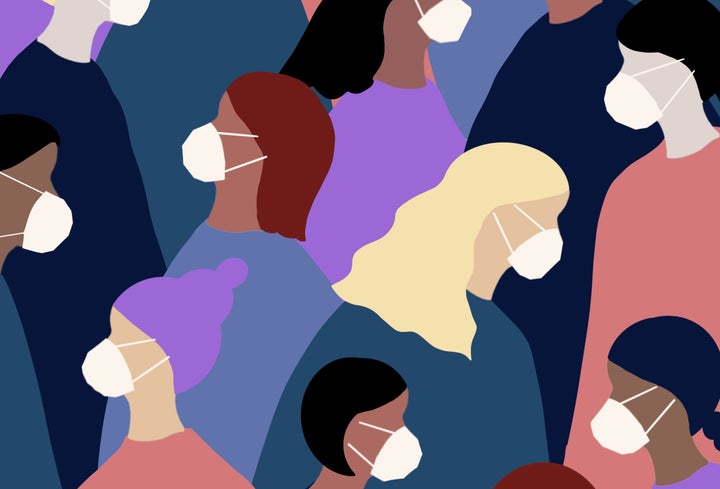There’s a sign near the elevators on every floor of my apartment building imploring residents and food delivery couriers to keep 1.5 metres apart in the elevators. Once in the elevator, the note tells us “not be embarrassed to face the corners to avoid exhaling onto others.”
My first thought when I read it? Cute ― but why not just wait for the next elevator? (Apparently, I’m not the only one who feels that way. There’s an ongoing debate on my apartment’s community Facebook page about how to proceed with an elevator that already has an occupant. I’m not involved, but let me tell you, it’s getting heated.)
There’s bound to be more disagreements along these lines as we venture further into our brave new post-coronavirus world. When it comes to social distancing, we all have different interpretations of the rules.
Given the newness of this situation, that’s completely understandable, said Jodi RR Smith, an etiquette expert and author of “From Clueless to Class Act: Manners for the Modern Woman & Manners for the Modern Man.”
Humans are, after all, creatures of habit ― and few of us were in the habit of acting like there was a six-feet protective force field around us prior to this.
“There is a learning curve to incorporate social distancing into our daily routines. We are still in this learning curve,” she said. “Human beings are notoriously bad at dealing with unknowns and this often leads to risky behavior. Right now, there is just so much we do not know about the virus, how it spreads and how to best treat it.”
To help us get a little farther along on that learning curve, we asked Smith and other etiquette experts to weigh in on some of the more common distance-requiring scenarios we’ve experienced lately. Here’s what they had to say.
What do you do if you go to get in an elevator but see someone else is already in it?
Obviously, if you’re feeling sick but have to be in the elevator for whatever reason, warn anyone who is about to board of your condition so they can wait for the next one, said Thomas P. Farley, a New York-based etiquette expert and the host of the podcast “What Manners Most.”
If you’re about to hop on and see someone else in the elevator, feel free to wait for the next one. That said, if you’re already on, you may have to lower your expectations for others boarding.
“Are you going to exit the elevator ― on whatever floor! ― anytime someone else gets in?” Farley said. “Someone who lives in a multi-story building cannot realistically expect others to do the same as they do.”
Avoid crowded elevators as much as possible ― and hey, if you’re physically able, consider taking the stairs.
“It’s not a bad idea since so many of us are missing our gym workouts these days!” Farley said.

What do you do if you’re a runner who sees a pedestrian coming up on the sidewalk?
Though it’s a highly debated topic, a recent research model suggested that respiratory droplets from bikers and runners may spread 33 to 65 feet depending on their speed.
Out of courtesy and an abundance of caution ― always good rules of thumb during a global pandemic! ― runners and bikers in metropolitan areas where there is a decent amount of foot traffic should stick to the streets and stay off the sidewalks, Farley said.
“I’m a runner myself and I leave the sidewalks to the pedestrians,” he said. “Run against the flow of car traffic so you can always see any oncoming vehicles, of which there are far fewer these days.”
If you’re in a suburban area where there is little to no pedestrian traffic on the sidewalk (and no safe place to run on the road), runners should yield to an approaching pedestrian.
“Arc out into the street ― looking both ways before doing so, of course ― to allow the pedestrian to have a safe buffer radius,” Farley said.
What do you do if someone is an aisle-crowder?
Aisle crowding at markets may be one of the most high-stress experiences right now. That’s especially true for grocery store employees.
One grocer HuffPost recently interviewed described how tense and unsafe situations can get on the job because of rude customers: “When I’m stocking the meat counter and people are crowding around me … that’s not social distancing,” he said.
That’s clearly unacceptable. If you’re a customer, you should be going above and beyond to respect the boundaries of all essential workers in this current climate.
“It’s so important that customers aren’t just giving staff the space they need but also showing gratitude for the essential service these folks are providing,” Farley said. “These people are allowing us all to bring essential foods and medicines home to our families.”
How can you politely ask for your space if you’re the grocery store employee in this scenario? First, employees and managers in places still open to the public should be having constant and open conversations about maintaining safe boundaries, Smith said.
“In the situation described in that story, the management of the store should be making frequent announcements reminding shoppers to make way for the employees,” she said. “Something like, ‘Attention shoppers, we are doing all we can here at X to serve you and your families during this time. To best protect you, please stand back from our stockers to allow them to fill our shelves with minimal contact.’”
Managers should also be walking the aisles to politely remind customers not to crowd employees or each other ― and obviously, there’s nothing wrong with customers or employees bringing up social distancing rules with aisle-crowders.
If crowding continues to be an issue in markets, Smith says management should consider creating a buddy-system in the stores, so there are a stocker and a blocker during busy times.
“Think of how the Disney characters at the parks have always have a minder nearby to manage the crowds,” she said.
Another option? “Management might want to consider printing up new uniforms such as florescent orange shirts, with block letters on the back ‘Please stand back. Thank you.’”

What do you do if you encounter someone who is not wearing a mask?
As of Monday, masks and face coverings are required in seven states. In cities like Los Angeles, essential businesses like grocery stores and restaurants can even refuse service to customers who aren’t covering up.
Of course, some folks are still going mask-free. If you run into a mask-less person while outside or in a public setting, it’s your right to keep your distance and dodge running into them, said Diane Gottsman, an etiquette expert and author of “Modern Etiquette for a Better Life.”
“Depending on the situation, if it directly affects you, you don’t have to put yourself in the situation,” she said. “Safety is most important here.”
What do you do if you need to tell someone to give you more space?
When asking someone to kindly back up, it’s all about how you deliver the message. Use a light, relaxed tone ― or even a jokey delivery, like “Wow, I can’t believe this is our new normal, heh, but would you mind if we both back up a little?” Smith said.
“That said, in general, a simple ‘Excuse me, let’s keep our space just in case one of us is contagious’ is enough to remind most people of the need for distance,” she said.
Since we’re all learning as we go along with this, be forgiving when people slip and get a tad too close. Don’t presume malice on part of the other person if you’re the one asked to back up. You never know what’s going on with someone who makes the request.
“They could be new to social distancing, they could be an essential worker coming off a long shift or they could be responsible for someone who is immunocompromised and worried about even being out and about,” Smith said.
A good rule of thumb for social interactions these days? “Start from a place of kindness and only escalate if necessary,” she said.
- Stay up to date with our live blog as we cover the COVID-19 pandemic
- What happens if we end social distancing too soon?
- What you need to know about face masks right now
- How long are asymptomatic carriers contagious?
- Lost your job due to coronavirus? Here’s what you need to know.
- Everything you need to know about coronavirus and grief
- Parenting during the coronavirus crisis?
- The HuffPost guide to working from home
- What coronavirus questions are on your mind right now? We want to help you find answers.
- Everyone deserves accurate information about COVID-19. Support journalism without a paywall — and keep it free for everyone — by becoming a HuffPost member today.
